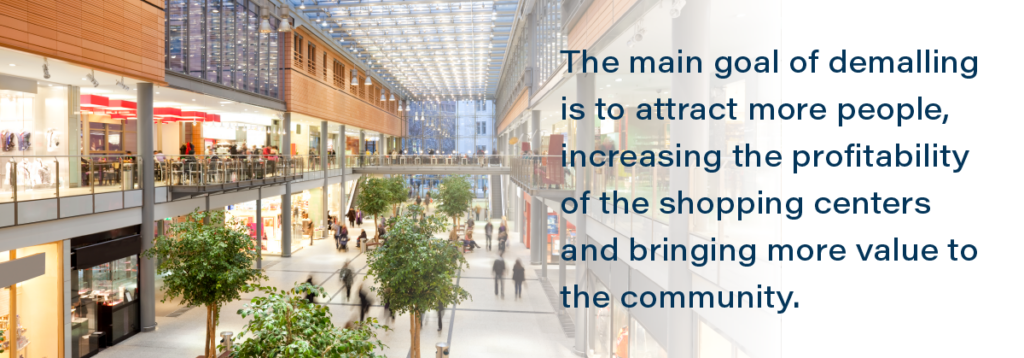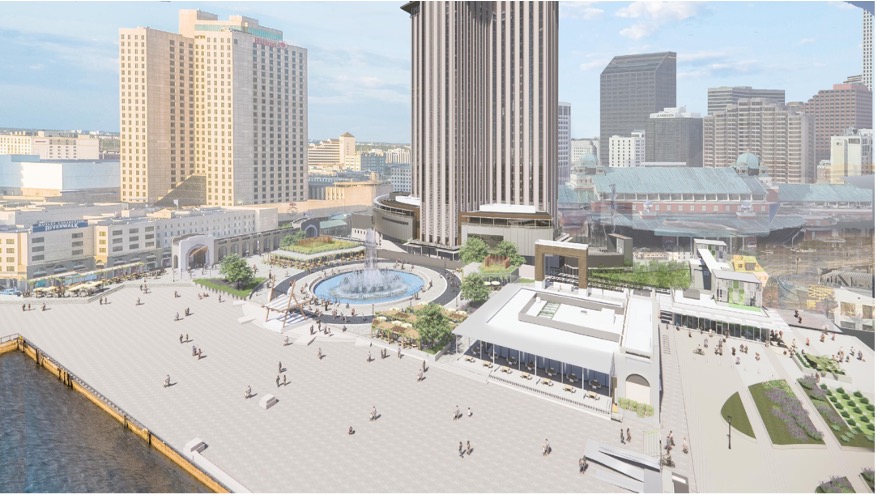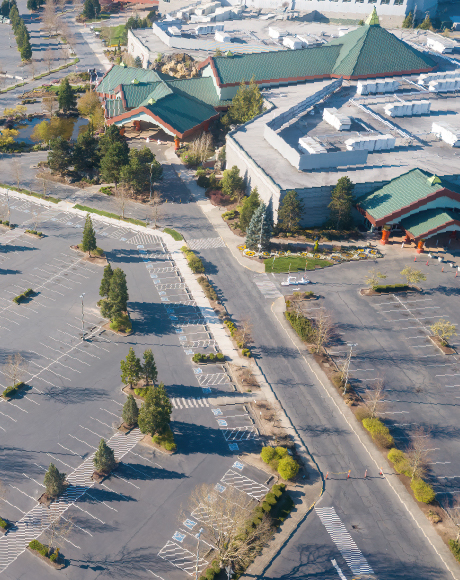It’s no secret that the internet and online shopping have dramatically shifted retail patterns. Though the idea of purchasing goods on a computer was once revolutionary, the introduction of Amazon in 1995 changed America’s browsing habits for good—96% of Americans have now bought something online. This widespread adoption of the internet as a means to shop has left many wondering, “are traditional malls dead?”
The answer is no; traditional malls are still very much alive. A large segment of the population would rather shop in person than on a screen, and many retailers make sales online based on customers’ interaction with products in-store. Customer expectations for malls have shifted, but successful malls are shifting with them. In fact, the malls that have evolved to meet new customer demands and desires aren’t just surviving, they’re thriving. One of the most successful transformation methods? A process called “de-malling.”

What Is De-malling?
De-malling is the process of taking traditional mall spaces and creating areas focused on entertainment, dining and socialization. This often includes softening the divide between indoor and outdoor areas. De-malling takes once single-use spaces and transforms them to meet the needs of more consumers. Research shows that almost half of U.S. shoppers choose the mall they shop at based on the food options that are available there. These shopping centers are no longer a place just to shop, but to socialize, share a meal and be inspired. The main goal of de-malling is to attract more people, increasing the profitability of the shopping centers and bringing more value to the community.
E-Commerce Pitfalls
Why are property owners de-malling? For one, many retailers continue to gravitate toward brick-and-mortar stores as they remain a profitable option for increasing sales, and they’re more likely to see transactions at locations where de-malling has taken place. Customer acquisitions are becoming increasingly expensive online and marketing costs are rising for digital ads. The reason? The market is oversaturated—just about any business with a social media account can begin making sales, targeting a much wider audience than ever before. To reach people in a growing sea of shopping choices, retailers need to spend more money. This means acquisition costs for new customers online are high, sometimes upwards of $100 a customer.

Overall, brick-and-mortar initiatives are trending positive for 2023. Real estate investment firms agree that more than half of retail markets nationally will be in recovery or expansion mode in 2023. Many retailers are choosing to expand, even some businesses that have historically been closing physical locations, like Barnes and Noble. Businesses looking to establish or expand physical locations might find that de-malling helps improve sales conditions, drawing in more customers and attracting more businesses. For property owners looking to support their retail partners, provide unmatched community value and revive once-booming shopping centers, de-malling is quickly becoming a favorable strategy.
De-malling Satisfies Consumer Preferences
For a property to succeed, a firm understanding of consumer habits is necessary, and the ability to shift to meet these demands is vital. What are the factors driving people offline and into storefronts?
Certain segments of the population far prefer shopping in person. Studies show the older a person, the more likely they are to shop at physical stores. For younger generations, in-person purchases might save them money, particularly on shipping costs, while also providing more convenience in the case of returns or exchanges. Customer service representatives are also much more accessible in person. For some consumers, physical interaction with a product they’re considering purchasing is key. Even if they don’t buy the item in-store, online purchases often begin in a physical storefront.

Perhaps the most powerful incentive for de-malling comes from why consumers head to the mall. Unlike in decades past, shopping is about much more than making a purchase. Over 50% of shoppers go to the mall for other reasons, including to socialize, discover something new and be entertained. At properties that have been de-malled, entertainment, food and socialization opportunities rise, bringing in more people who are looking for a diverse shopping experience.
Examples of De-malling
The American Dream in New Jersey is a prime example of a shopping center that’s transformed to meet consumers’ demands. This three million-square-foot property doesn’t just host national brands like Apple, Gucci, Levi’s and more. The American Dream has dozens of local restaurants, an indoor waterpark, mini golf and other non-traditional entertainment opportunities. Since November 2022, the number of visitors at the mall has increased by as much as 40%, and people driving in to pay a visit sometimes wait two hours to park in the expansive neighboring lot. The American Dream has transformed the mall experience into a social one, where people can come together to shop, dine or play in one place.
Following an $85 million refurbishing investment, the premier 1.1 million-square-foot Newpark Mall combines in-demand retail brands with restaurants and entertainment. The property is gradually evolving to serve as the center of the community. Newpark Mall is hoping to focus on becoming a pedestrian-friendly zone with enhanced biking trails and larger public spaces. This shift toward a mixed-use property is a prime example of de-malling in action.
RockStep’s Plan
As a leading real estate investment firm, RockStep Capital is implementing de-malling strategies at our properties to adjust to community desires and evolve our shopping centers to succeed in the modern era.
Take our premier property, Riverwalk Outlets in New Orleans, Louisiana. RockStep is elevating this newly-acquired shopping center, located just off the Mississippi River in downtown New Orleans, to be the epicenter of shopping, dining and entertainment in the city. We’re bringing in high-end luxury retailers like Karl Lagerfeld Paris, and supporting local events and entertainment opportunities, like the Lundi Gras on the Riverwalk, a festival attended by thousands of people in February 2023.

Plans for Riverwalk Outlets include updating the Spanish Plaza, which will become a focal point for fine dining and entertainment while acting as the entry point for the surrounding riverwalk. The new designs include a reworked fountain display at the hub of the space and a stage for local performances and shows. Alongside fresh covered, outdoor seating, new outward-facing restaurants in the larger spaces in the outlet will transform the Riverwalk into a prime destination for those looking for New Orleans entertainment, shopping and dining.
One of RockStep’s core strengths is our ability to evolve with market trends—it’s the reason why we’re called RockStep Capital, named after the quick-step dance move. We’re determined to stay ahead of the demand for unique customer experiences, reconfiguring our properties to align with the “live, work, play” lifestyle to provide unmatched value to their communities. If you’re ready to invest in the future of retail real estate with tools like de-malling, you’ve come to the right place.
